What do size marks on bicycle tyre package mean, how to “read” them, which bicycle tyre size can fit a given rim? This post answers all those questions, providing an easy, uniform, standardized way to tell a tyre (tube and rim) size using ISO (ETRTO) standards. For detailed tube sizing gude, see: Bicycle tubes – types, valves and sizing explained. Effect of tyre size on speed and comfort is explained here: Are narrower tyres “faster” – rolling resistance.
TL/DR
Here, I’ve explained how you can read and understand bicycle tyre size marks (why and how 700 C is the same diameter as 28″ x 1.75 or 29″ – all being the same 622 mm diameter tyres).
I’ve also explained which tyre widths you can fit on your rim and bicycle frame (and how to measure your rim width and frame tight spots).
In the bicycle tubes article I’ve explained which tube dimensions can fit which tyre sizes (and valve types).
1. Expressing (noting) bicycle tyre dimensions
1.1. OBSOLETE “Inch” and “French” “standards”
At first, tyre dimensions were expressed through mounted (and inflated) tyre outer diameter. That is why today we still often note tyre sizes like 26″ (now less often), 27.5″ or 29″ for MTB, and 28″ for road bicycles. A 26″ tyre fits on a rim with a 559 mm diameter. When a 2″ wide tyre is mounted on such rim, the outer diameter of such wheel with an inflated tyre is around 660 mm (26″). To further complicate things, different standards were made in different countries. This led to situations that same sized tyres were differently noted, or that the same dimension note was used for tyres that differ in size. Does this sound complicated and confusing already? 🙂 Here’s a picture that takes 26″ “size” as an example:
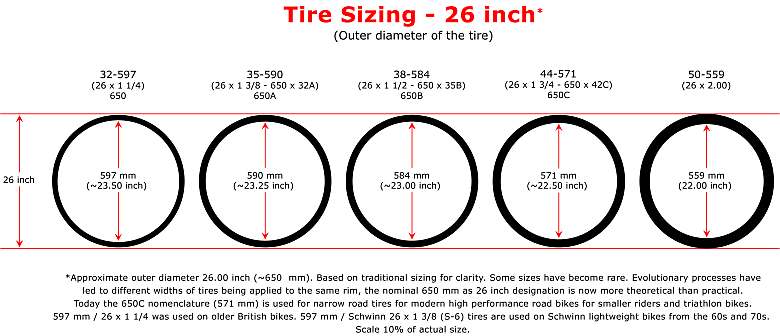
1.2. ISO ETRTO – the true standard!
That is why ISO standard notation was introduced and is in use today. Standard was introduced by ETRTO (The European Tyre and Rim Technical Organisation). Diameter of wheel tyre bead seat in millimetres preceded by tyre width in millimetres. Tyre width is also a bit non-exact measurement. It is width of an inflated tyre mounted on a rim of standard width for that tyre size. However, the most important information: wheel bead diameter is noted exactly in millimetres, so there can be no confusion. 559 wheel and tyre are always compatible (at least in terms of diameter, see about tyre and rim width compatibility below).
Note:
ISO ETRTO puts tyre width first, followed by the tyre’s diameter (for example: 40-622).
Unlike the old “inch” (28×1.50″) and “French” (700x38C) standards, that often put the diameter first, followed by the width.
That is my main complaint about the ETRTO standard: it makes no sense to put the width before the diameter!
When bead seat diameter (BSD) is known, a tyre of appropriate dimensions in mm is required. It is as simple as that.
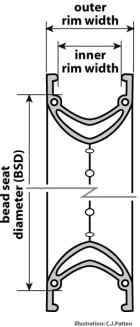
For example, the 26″ wheel diameter is 559 mm and it can take practically any tyre of that BSD, whether wider, or narrower, such as 47-559 (26×1.75″ by old nomination), 60-559 (2.35×26″ by old nomination) and so on. All the manufacturers today mark tyres with ISO dimension standards, sometimes adding old nominations as well, but ISO is always noted and can be used as a safe(st) reference.
Standard road bicycle wheel size today is 622 mm and it usually takes tyres of 23-622, or wider 25-622. Today when off road bicycles with wheels larger than standard MTB wheels started to be popular, it’s wheels are marketed as 29″, but in fact are 622 wheels with wider tyres (so that outer diameter is close to 29″). Tyres for those bicycles are always marked with ISO standard (sometimes along with the “old” standard 29″) saying something like: 57-622, 60-622 and similar, depending on tyre width.
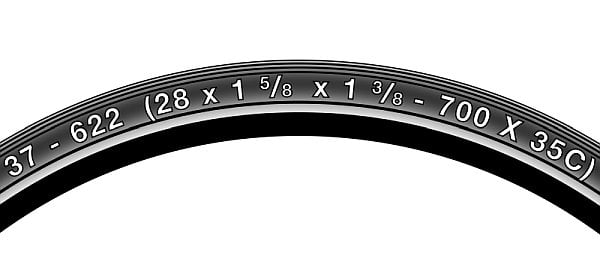
1.3. TABLE: Standard bicycle tyre dimensions
In case a tyre has no ISO (ETRTO) marks, here is a cross-reference:
| ISO (ETRTO) Bead Seat Diameter | Traditional Designations |
|---|---|
| 787 mm | 36 inch |
| 686 mm | 32 inch |
| 635 mm | 28 x 1 1/2, 700 B |
| 630 mm | 27 x anything except “27 five” |
| 622 mm | 700 C, 28 x (two fractions), 29 inch, 28 x 1 1/2 F.13 Canada Road 28″ wheels and MTB 29″. |
| 599 mm | 26 x 1.25, x 1.375 |
| 597 mm | 26 x 1 1/4, 26 x 1 3/8 (S-6) |
| 590 mm | 26 x 1 3/8 (E.A.3), 650 A |
| 587 mm | 700 D |
| 584 mm | 650B, 26 x 1 1/2, 27.5″ MTB 27,5″ wheels |
| 571 mm | 26 x 1, 26 x 1 3/4, 650 C |
| 559 mm | 26 x 1.00- x 2.125, also fatbike tyres up to 5 inches wide MTB 26″ wheels. |
| 547 mm | 24 x 1 1/4, 24 x 1 3/8 (S-5) |
| 540 mm | 24 x 1 1/8, 24 x 1 3/8 (E.5), 600 A |
| 520 mm | 24 x 1, 24 x 1 1/8 |
| 507 mm | 24 x 1.5- x 2.125 – Big kids bikes with 24″ wheels. |
| 490 mm | 550 A |
| 457 mm | 22 x 1.75; x 2.125 |
| 451 mm | 20 x 1 1/8; x 1 1/4; x 1 3/8 |
| 440 mm | 500 A |
| 419 mm | 20 x 1 3/4 |
| 406 mm | 20 x 1.5- x 2.125 – Kids small 20″ wheels, BMX. |
| 390 mm | 450 A |
| 369 mm | 17 x 1 1/4 |
| 355 mm | 18 x 1.5- x 2.125. Kids’ bikes with 18″ wheels. |
| 349 mm | 16 x 1 3/8 |
| 340 mm | 400 A |
| 337 mm | 16 x 1 3/8 |
| 317 mm | 16 x 1 3/4 |
| 305 mm | 16 x 1.75- x 2.125 – Kids’ 16″ wheels. |
| 288 mm | 14 x 1 3/8″ |
| 254 mm | 14 x 2.00. Kids’ 14″ bike wheels. |
| 203 mm | 12 1/2 X anything. Small kids’ 12″ wheels. |
| 152 mm | 10 x 2 |
| 137 mm | 8 x 1 1/4 |
Table 1
2. Tyre widths
After explaining tyre dimensions, a few words on tyre widths. Generally, narrower tyres are good for fast road riding on pavement, while wider tyres are better suited to rough terrain, or heavily loaded bicycles (heavy rider, carrying children or heavy baggage on a bicycle etc.). Depending on rim width, a range of tyre widths can be used. The important measure here is inner rim width. Outer rim width is irrelevant (for this purpose), just the inner rim diameter.
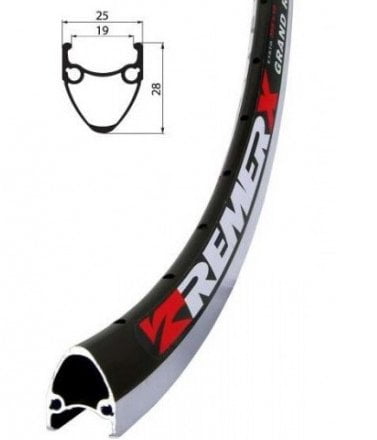
2.0.1. Which tyre width can fit which rim widths
The following table tells the range of acceptable tyre widths depending on inner rim width, expressed in mm, according to ISO (ETRTO) standard:
| Tyre width (mm) / Rim width | 18 | 20 | 23 | 25 | 28 | 32 | 35 | 37 | 40 | 44 | 47 | 50 | 54 | 57 | 60 | 62 |
| 13 | x | x | x | x | ||||||||||||
| 15 | x | x | x | x | ||||||||||||
| 17 | x | x | x | x | x | x | x | x | x | |||||||
| 19 | x | x | x | x | x | x | x | x | x | x | ||||||
| 21 | x | x | x | x | x | x | x | x | x | x | ||||||
| 23 | x | x | x | x | x | x | x | x | x | |||||||
| 25 | x | x | x | x | x | x | x | |||||||||
| 27 | x | x | x | x | x | x | ||||||||||
| 29 | x | x | x | x |
Table 2
2.0.2. Which fat-bike tyre width can fit which fat-bike rim widths
Fat-bicycle tyre sizing chart:
| Tyre width (mm) / Rim width | 65 2.60″ | 70 2.80″ | 80 3.10″ | 100 4.0″ | 110 4.40″ | 115 4.50″ | 120 4.80″ |
30 | x | x | x | ||||
| 31 | x | x | x | ||||
32 | x | x | x | ||||
33 | x | x | x | ||||
34 | x | x | x | ||||
35 | x | x | |||||
40 | x | x | |||||
45 | x | x | |||||
50 | x | x | x | x | |||
| 70 | x | x | x | ||||
| 100 | x | x |
Table 3
2.0.3. Schwalbe’s complete size chart
Below is a chart which includes many modern (more recent) tyre and rim widths. It was made by the Schwalbe company and in my experience it is a safe guide (I’ve even exceeded the there-recommended ranges without problems). Both the dark-blue Schwalbe range, and the light-blue ETRTO range are fine – as long as you stay within either of those, you’ll be fine:
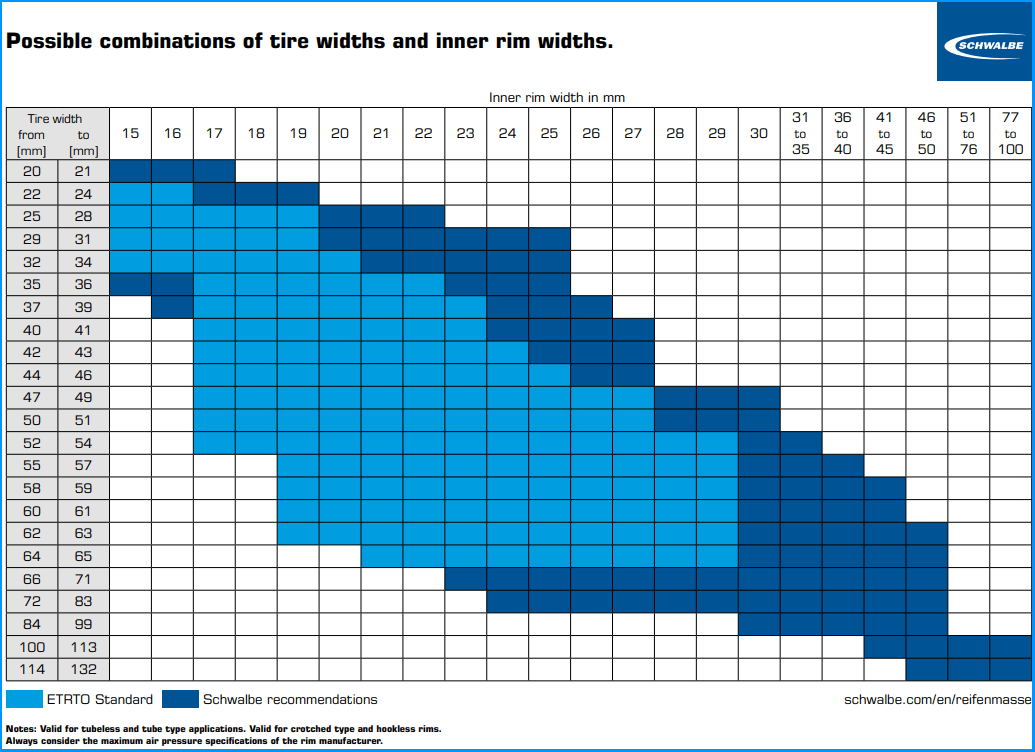
Source: www.schwalbe.com
Table 3b
2.1. Why is it important to use an optimal tyre with for your rim width?
If a tyre that is too narrow is mounted on a wide rim, the rim can easily be damaged on a bump. If too wide a tyre is mounted, there is a risk of the tyre coming off a rim (with a loud explosion of the tube). Either of the two extremes can reduce traction and comfort (shock absorption), and distort the optimal tread/knob design. In addition to that, using a tyre that is too wide for the rim width can expose the tyre’s sidewalls to cuts (I’ve had this “pleasure” with a rather expensive 28mm tyre mounted on a 13 mm wide rim).
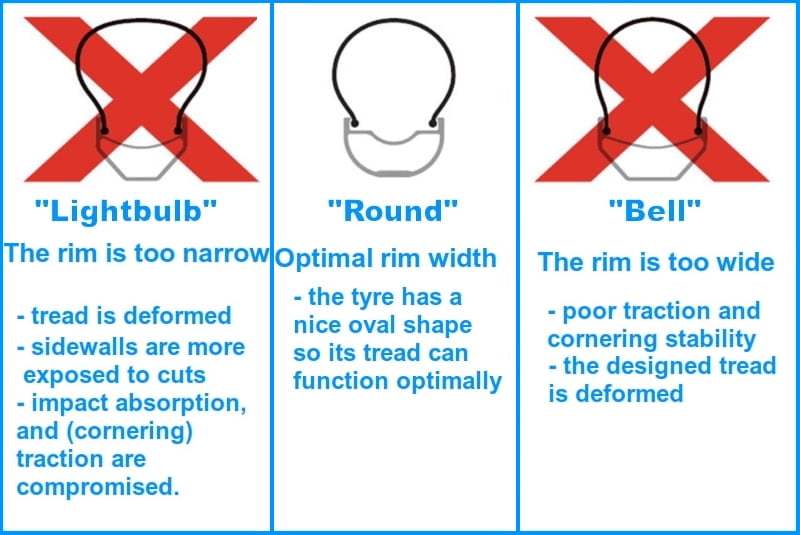
Source: Stan’s NoTubes
3. Frame clearance (MAXimum width)
If there’s limited space for fitting tyres in a frame, note that rim width also influences tyre width and height when mounted:
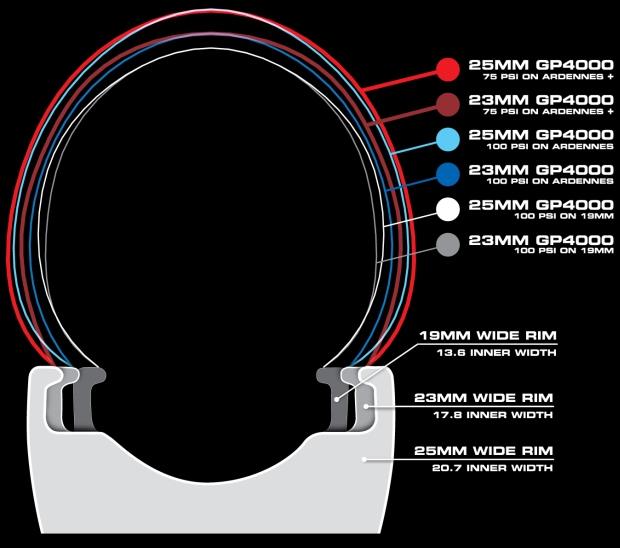
It should be also noted that one nominal tyre size (e.g. 622-28), in various models and manufacturers, is not of the same actual width when mounted and inflated. Some models are known to be of a smaller “real” size, some are known to be larger. If, for example, the old tyre has a nominal width of 23 mm, and one considers replacing it with a wider one of 25 mm (nominal) width, and there is only about two mm extra room, it should be confirmed what the actual tyre widths when mounted are. If the old 23 mm tyre is among the “narrower 23s”, and the considered 25 mm one is among the “wider 25s”, it is very likely that the wheel will not fit into the frame with the new tyre.
3.1. Common tight spots for mounting wider tyres
Pictures below are taken on a frame with lots of extra room for wider tyres (and mudguards). They are just a demonstration of where the “tight” spots usually are, and where attention should be paid (and measuring taken) before going for wider tyres. Depending on frame geometry and brake type, some other spots may be the tight ones. It should always be checked and measured at the tightest spot, with the least tyre clearance – and that is usually in (one of) these places:
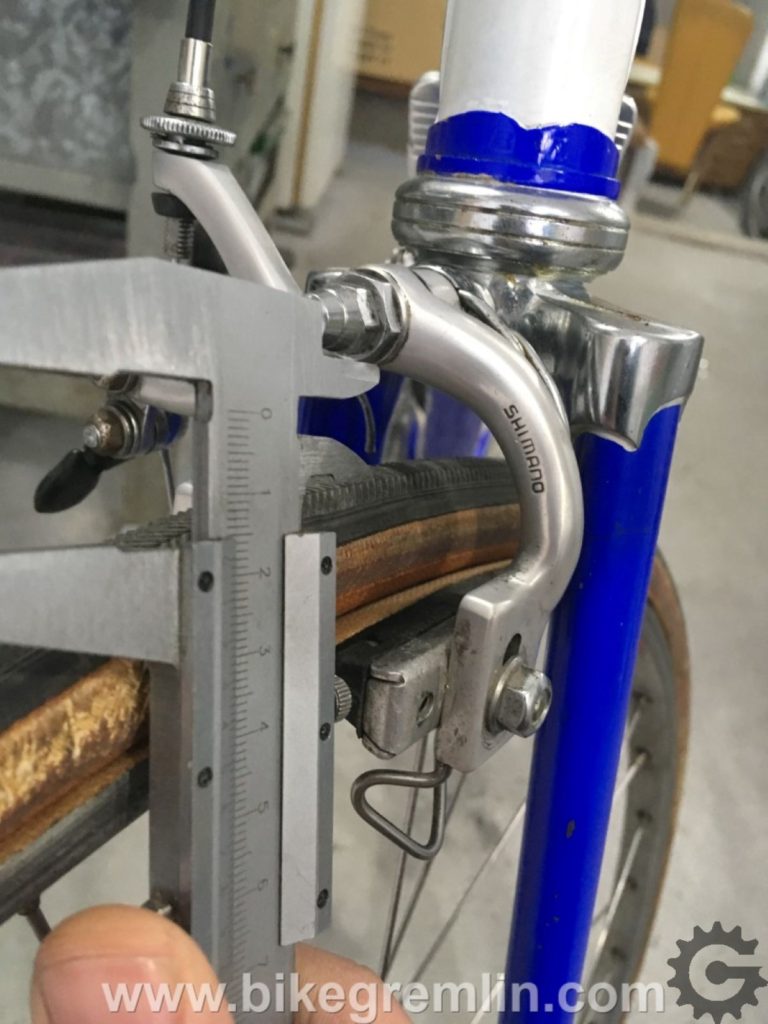
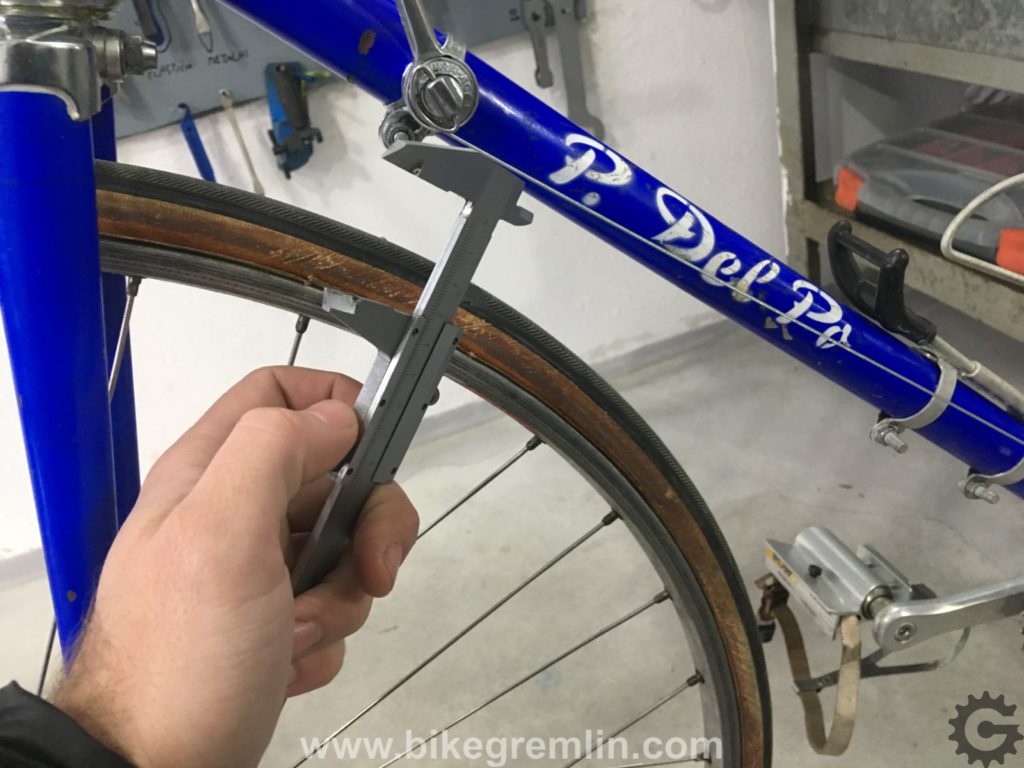
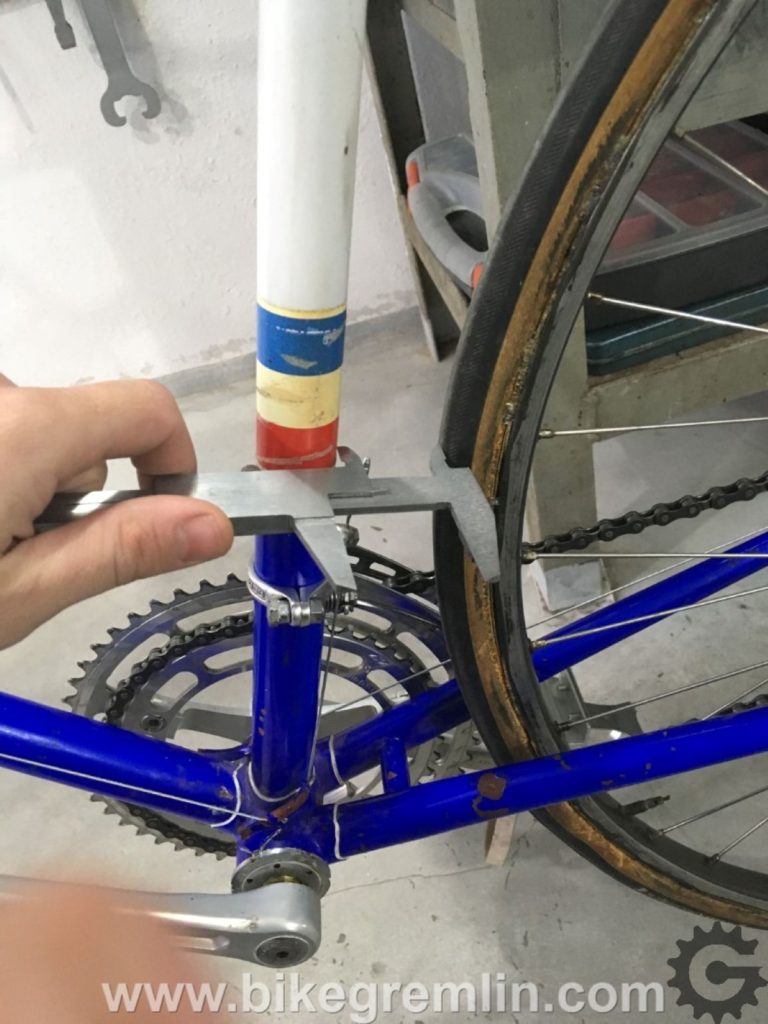
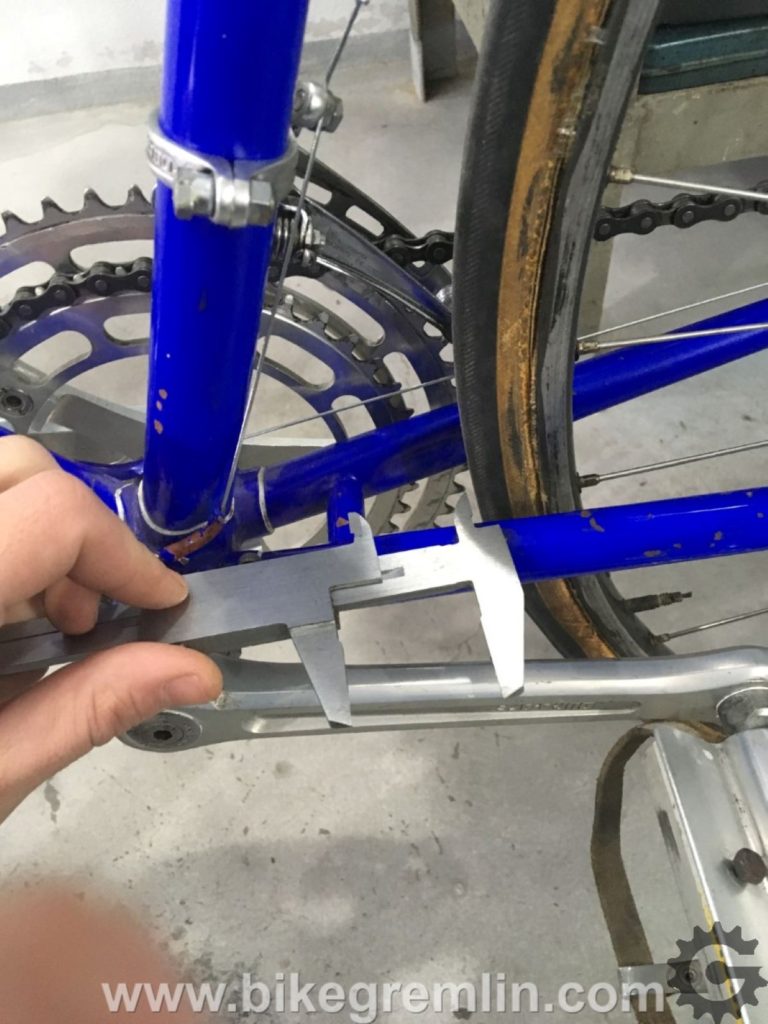
The bicycle in the picture has huge clearance – they used to make them properly in the 70s 🙂
3.2. Real tyre height relative to its pressure and nominal size
Table overview of how tyre inflation pressure affects its real height, depending on its nominal size (dimension) – inner rim width used or measuring was 19 mm:
| Tyre model and nominal dimension | Real height at 3 bars pressure | Real height at 4.5 bars pressure | Real height at 6 bars pressure |
|---|---|---|---|
| Continental Grand Prix 4-Season ETRTO 622-28 | 27 mm | 27.5 mm | 28 mm |
| Continental Terra Trail ETRTO 622-35 | 32 mm | 32.5 mm | 32.75 mm |
| Schwalbe Lugano 2 ETRTO 622-25 | 22 mm | 22.5 mm | 22.75 mm |
Table 4
3.3. Real tyre width relative to its pressure and nominal size
Table overview of how tyre inflation pressure affects its real width, depending on its nominal size (dimension) – inner rim width used or measuring was 19 mm:
| Tyre model and nominal dimension | Real width at 3 bars pressure | Real width at 4.5 bars pressure | Real width at 6 bars pressure |
|---|---|---|---|
| Continental Grand Prix 4-Season ETRTO 622-28 | 29.5 mm | 29.7 mm | 30.1 mm |
| Continental Terra Trail ETRTO 622-35 | 34.7 mm | 34.8 mm | 35.15 mm |
| Schwalbe Lugano 2 ETRTO 622-25 | 24.6 mm | 24.8 mm | 25.3 mm |
Table 4
4. Tyre size and fitting/clearance video
5. Sources
- Tire Sizing Systems – by Sheldon Brown and John Allen
- WIDERIGHT – Stans no tubes website
- Schwalbe tire and dimension charts
- Mavic rim compatibility table
Related post – To what pressure should I inflate my bicycle tyres:

Last updated:
Originally published:
Reader questions/comments and replies – below:
The existing comments posted under this article (questions and answers) have been moved to this BikeGremlin forum thread:
https://www.bikegremlin.net/threads/bicycle-tyre-sizing-and-dimension-standards-article-comments.103/

Thank you, really!
BW from Hungary!
I have a road bike and hybrid bike with front tire sizes 700×23 and 700×40. I want to get one wheel that can fit on both bikes (the wheel has an electric motor). I believe the road bike rim inner width is 15mm. Is it possible to fit a wheel with 17mm inner width on the road bike? Can the road brakes be adjusted to fit wider rim? Can i get brakes that will fit wider rim?
Short answer: yes, no problems.
Brakes on a rim with a 2 mm more outer width need to go out by just 1 mm at each side.
There is a tendency for road bike rims (and tyres) to go wider. For both comfort and aerodynamics (wider tyres being more aero on wider rims, than narrower tyres).
Your image showing the cross-section of 2 tires mounted on 3 different rims at different pressures looks like it may contain many errors.
The same tire is shown as being wider and taller on a wider rim, than it is on a narrower one. Assuming all have 622 bead seat, how is this possible? What’s more, it appears taller and wider at 75psi than it does at 100psi on the same rim.
It is counter intuitive, but yes, a tyre can get both wider and taller on a wider rim. Depending on rim’s inner width (bead seat width) and tyre’s width.
As for the rest – which cases in particular you think are problematic?
Most of them are problematic actually.
A 25mm GP4000@75psi is same height but wider than the same tire @100psi on the same Ardennes rim.
A 23mm GP4000@75psi is same height but wider than the same tire @100psi on the same Ardennes rim.
(the only 2 I’m not questioning is on the narrowest rim).
—————————————————————————–
PS: can you follow the link to my website that I entered ( Velo76.com ) – it will redirect you to my FB group, you can see me there as admin (Timm S…) and add me. I’d like to bring something else up with you – it might be more productive to do it in messenger than a reply every few months on here.
Will do – though I reply almost daily on most comments here. Definitely not “every few months”.
As for the graph – GP4000@75 is mounted on a 20.7 mm inner rim width, while the 100 PSI graphs are made for 17.8 and 13.6 mm rim widths.
Wider rim makes tyre’s circumference effectively larger. That is the point. So it can be wider, while not being of lower height, even under a bit lower pressure.
I’d also like to raise the question of the TIRE VERSUS RIM WIDTHS in the table.
These types of tables can be very helpful, but I would like to give a word of caution about it. I’d like to illustrate my point with a personal experience, if you’ll just bear with me:
I went to slightly wider tires, up from my usual 23c-25c, to 28c, but didn’t change my wheels.
700x28C tires, mounted on 15mm inner width rims, at 80psi (this is the max for many affordable 28c tires, although a Continental can go much higher. The ones I had on that day were the Michelin Dynamic).
Cornering on asphalt, I could feel the back wobble as the tire tried was folding under the rim and redressing itself, ove and over, as it went over a very slightly uneven paved surface (just your usual city road). It would bend, then redress itself with rotation when the road dipped down slightly, then folded again. This felt very dangerous. Luckily it didn’t fold under completely, but had I gone a little bit faster, it surely could have.
So in this example, for a 15mm rim, 32c should be stricken off that line, and perhaps the 28C as well (80psi is the max on many 28c tires from Kenda to Michelin, so you can’t just say to up the pressure).
True, tire width and pressure depends on riding style and type of riding. A mountainbike, on dirt trails, can take much wider tires per rim width, than a road bike can. The MtB will slide on dirt surface, the road bike’s tires will grip and not slide, when cornering hard (unless you have very hard budget tires on the road bike).
I think you need to err on the side of safety here. And take off a at least 1 checkmark from the right on some of those “acceptable” tire sizes per rim widths. It won’t help a young enthusiast who likes to ride fast, and has an accident, slipping under a truck in a turn, because the tire flopped over, sending him into a high-speed slide (or off a cliff). It won’t help the more tame cyclist who is in an emergency situation and makes a sharp turn.
A 32c on a 15mm rim is definitely a no-no. 28C on the 15mm rim is debatable (sometimes safe, sometimes not as in my anecdote). In fact, the entire table could be shifted to the left, in order to be more accurate. I realize that some manufacturers will publish overly optimistic numbers, but that’s just because they want to sell more tires – and if they tell people to buy new wheels to get wider tires, they won’t be selling wider tires to folks who already have tires.
I ran 28 mm Continental Grand Prix 4 seasons on 13.5 mm wide rims with no problems. At 5 to 6 bar pressure.
For all I know, the table is more on the conservative/safer side – at least in my experience.
It is also my experience that manufacturers are more often “too conservative”, than “too optimistic” – probably in order to avoid any law problems.
Your feedback is valuable to me – it certainly requires more looking into. However, it does not align with my own previous experience, nor with the experience of other riders I know. For the given table, I took info from Mavic (as a rim manufacturer) and Schwalbe (as a renowned tyre manufacturer) – using the more conservative option in cases of any mismatch – and making sure it does align with my own experience.
I actually run Bontrager 28mm AW1 Front and 32mm H1 Rear on my 23mm rims very successfully for over 18 months now mostly road but some gravel paths too.
These are both off your chart on the left hand end of the scales.
These tyres were both ‘last in stock’ at my LBS at the time (hence different sizes) and sales assistant assured me it was ok and a good move from my 36mm Clement X’plore MSO chunkies provided with my gravel bike which made so much noise on the roads.
What you describe is tyre squirm, and it’s common with wider tyres at low pressure on narrower rims. I use 28mm tyres (various types over the years – IME those Michelins cut very easily on gravel) on 13.5mm internal width MA40 rims at about 80 PSI and have never felt that a tyre was going to roll off the rim or dump me on the ground – maybe I just don’t corner fast enough. I also use oversized tyres on skinny MTB rims and at low off-road pressure they will squirm on tarmac, so I just take it easy or add some air. There is another form of squirm, that’s caused by the tread moving relative to the tyre carcass, but that’s usually only noticeable with soft sticky knobbly tyres.
Hi, What size wheel do i need for a (58 – 559) 26 x 2.35 tyre and 7 speed.
Rim diameter should be 559 mm ISO (26″), while the rim’s wall inner width should be at least 21 mm.
As for the 7 speed cassette – see this article:
https://bike.bikegremlin.com/1259/bicycle-rear-hub-compatibility/
Hi,
Thanks for such a nice explanation. First a little background. I have a Drag bike Rodero TE exact specification like this one here; dragzone. bg/en/drag-rodero-te-bike-2018. It originally can with the Schwalbe Spicer K-Guard, 30-622 tires though the rim is designated at these numbers: ETRTO 622x13c. There is also this numbering, ERD: 593, I am not sure what ERD means. Anyways, while the ‘conservative’ chart says rim sizes of 622 x 13c (700x 13c) can fit as far as 25mm (700x 25c), my bike came fitted with 700x 30c. I have had no problems whatsoever until I recently changed to Maxxis Relix (SilkShield, One70) 700x23c tires because it seemed fine that they will fit nicely and 25c ones were not available. The roads that I am riding these days are a combination of gravel and tarmac. I have had flat tires several times and seems to me that this purchase hasn’t paid off. I want to change my tires to gravel types ones but I am eternally confused with the sizes. Looks like my rim can take as much as 700x30c, should I look for these sizes for gravel type tires? Or should I buy a separate wheel-set dedicated to gravel? While having a new wheel-set sounds nice, I am not very sure if my rim brakes (mechanical) and the 10 speed Shimano Tiagra cassette will be compatible. What will be the best course of action? Thanks in advance.
ERD is “effective rim diameter” – relevant for wheel building, when calculating the optimal spoke lengths. In this video, at 6:40 I explain how it is measured:
https://www.youtube.com/watch?v=i5ywzfr_dCg&list=PLlbCLBTvuIssCHYrqh9BM8IrtEV2SaD_3&index=4
As for the tyre sizes, the chart is rather conservative, at least in my experience. Also, some tyres are made “half a size” smaller, or larger, than what is noted on the sidewall. So you might “get away” with tyres wider than 25 mm on 13 mm rims. I would definitely measure the rim’s inner width just to be sure.
Having said this, wider rims will provide for more air volume inside the tyres, since tubes will expand more inside the rim, hence probably allowing for somewhat more comfortable ride with the same size of tyres, compared to narrower rims. The differences are not night and day, but they do exist.
I personally don’t like tyres narrower than 28 mm, even on road bicycles. Wider ones don’t need very high pressure, so they don’t have to be topped up too often and can be inflated with a small, cheap, portable pump that fits a patch kit easily. Also, lower pressure (wider) tyres are a lot less prone to punctures by sharp rocks, or glass shards, at least in my experience.
Hi. Thanks for your information in this article. I’m having trouble relating what I find in articles such as this to the tyre sizing for my daughter’s bike. She has a smaller bike being a child, 20 inch wheels. When I was shopping around for new tyres the narrowest I could find at 20 inch was 2.15 inch width. But the tyre I bought looks considerably wider than the existing one. I’m not sure it will fit. So i used your width table. Her inside rim width is 15 mm, and the table seems to suggest a max tyre width of 1.26”. But the tyre she has now is 1.5” and that looks fine. So I’m thinking that I have misunderstood what the tyre width in the table actually is.
Would you be able to help me check my understanding of the table? Thanks for any help you can give.
The given table is rather “conservative” – in terms that it gives combinations that will most certainly fit and work fine, with practically any rim and tyre make/model/diameter.
I have run combinations that are out of the limits given by the chart, with no problems.
So, to be on the safe side (without being able to see how the tyre fits a rim), the table should be respected.
Especially since some tyres are made to be a bit wider, or narrower than their sizing specifications show (depends on the manufacturer, and tyre model/mold).
Having said all that, bearing in mind that 1.5″ tyre is working fine, I wouldn’t shy away from using that width of tyres – just making sure they are seated well.
Hi there,
I have an old Gazelle city bike of 1973 with the tire dimensions of 28 x 1 3/8 x 1 5/8. It is quite difficult to find tires of those dimensions in my country, Indonesia. What is the alternative tire dimensions that suitable/compatible to the current tires dimensions? Any suggestion? thanks
Most tyres have ISO marks as well, especially ones made in the past 20 years.
If these don’t, however, I would try with 37-622 (32 mm wide “28 inch”) tyres.
I appreciate the information! Very clear and well thought out.
Thank you
So, which two wheelers performance is better? Two wheeler with bigger tyre or two wheeler with smaller tyre?.
Please give me ans.
It depends. I wrote on that topic in the article:
Are narrower tyres “faster”?
Thank you for this helpful article. I have a 1991 Giant hybrid. The tires are original and they say 26 x 1.38. The brochure says the tires are 38mm. But when the tires are inflated (85 psi per the sidewall) measuring as you show above the tires are only about 30mm wide. So what size tire should I buy to replace these and be as close to the originals as possible? Thank you!
I don’t know.
Different manufacturers, even different models of the same manufacturer, often end up with different widths (and heights) when inflated.
Another dilemma is whether to go with such narrow tyres for 26″ wheels. In my experience, 1.75″ (47 mm nominal width) are the sweet spot between ride comfort, handling and speed. For off-road, if going with knobby tyres, I go even wider.
Thanks for replying! I don’t think 1.75″ or even 1.5″ tires would actually fit my bike. It is like a hybrid but much more like a road bike than a mountain bike. Giant called it AFS (All-Terrain Fitness Sport), and these 26 x 1.38 tires are what came on it. I found the original brochure for it, and it says in one place that the tires are 38mm but in another place it says they are 26 x 1.38. Based on my measuring, I think they are 1.38″, not 38mm. I’m going to give it a go with a 26 x 1.4 and if the doesn’t work, I’ll try a 26 x 1.35. It is thanks to your article that I have a clue about all of this, so thanks so much!!
“559 wheel and tyre are always compatible.”
Some people may not read down as far as the rim/tyre width table.
I’ve seen some fairly incompatible combinations in use that “fit”, mostly too skinny tyres on bikes they want to “go faster” (all those bumps sure feel fast). I’m off the other side of the chart, running 28mm tyres on my road bike since 1990; it seems fashion has finally caught up with me (in tyre width at least).
Well noticed. I edited the article. Thanks. 🙂
Hi,
A brief question from me, is it true you can use 27 inch inner tube on 700 x 35c tire? 🙂
Thanks
Yes. At least all the ones that I’ve come across.
Hi, I have a ktm bike with fat tyres, 27.5 x 2.25. I would like to change the tyres without changing the rim, but i dont know if they will be compatible. The rim says “ktm taurus 27.5 ertro 584 x 21 made by ryde”. And the tyres I would like to fit are “schwalbe marathon plus 27.5 x 1.25 or 1.5. Do you know if its possible? Thanks
Hi,
Based on the info you provided, the new tyre matches the BSD of the rim.
All that’s left is to measure the rim BSD width – as explained in chapter 2 of this article.
Then look at the table 2 below to see if the tyre is a match.
If the rim’s BSD really is 21 mm, 1.5″ wide tyres will fit nicely, but 1.25 are not a perfect match.
Also, 1.25 is what I would consider a bit too narrow for a 27.5″ wheel.
1.5″ is closer to what I’d call “the sweet spot” in terms of tyre width for such wheels.
[Hi Relja,
Thanks for all the good advise and suggestions It still left me with a question:
I have a Shimano Ultra WH6800 Wheelset. I would like to put tape on the wheelset, however I don’t know the correct width of the tape to useThe tubeless tire size is 700 x 25 from Schwalbe.
I appreciate your expertise and knowledge
Marcel
Hi Marcel,
Short answer:
– Measure the rim’s internal width (first picture in 2nd chapter of this article – showin 19 mm in that case)
– Add 3 to 5 mm to what you’ve measured.
– You’ve got the optimal tubeless rim-tape width! 🙂
Long answer:
When the rim-tape is installed, its edges should climb a little bit up the “vertical” sides of the rim – but not too much.
The idea is to achieve two goals:
1) Prevent the rim-tape that is too wide, and climbs too high up the rim’s sidewalls, from interfering with the tyre seating onto the rim.
2) At the same time, by having the rim-tape slide up the sidewalls by 1 mm, or a bit more, keeps its edges covered by the tyre.
This prevents any air pressure from sliding under the rim tape, and “trying” to leak.
Also, when mounting, or removing a tyre, rim tape sides won’t get pushed by the tyre, or even by the tyre lever (accidentally), since the rim tape and the tyre will slightly overlap.
Basically: tubeless rim tape should fit a bit wider than I prefer with “standard” (tube tyre) rim tape, but still not too wide so it reaches the top of the rim.
I will add a drawing to the rim-tape article, explaining the optimal rim-tape widths for both tube, and tubeless tyres.
Hello and thank you for the article.
I would like some help. I have shimano rs 11 622*15c with gp400s2 25mm.
I would like to fit the new gp 5000 28mm. Do you think they will fit properly and will have a benefit from the 28mm or should i stick with the 25mm?
As you will probably know the gp4000s2 25mm are wider than the 25mm gp 5000.
Thank you in advance.
Billys
Hi Billys,
Measure the rim-s inner width and check table 2 to see if it will nicely fit the rim.
In my experience, 13.5 mm wide rims (and wider – up to, including, 19 mm) will work nicely with 28 mm wide tyres.
Before doing that, measure the tight spots on your frame with the current tyre (25 mm wide one).
Pictures in the chapter 3 of this article show these tight spots. The bike in the pictures has huge gaps, loads of clearance, but is good for the demonstration. If your bike has 3 mm, or more room, I’d expect the 28 mm tyres to fit.
If it has less, then even if the tyres do fit, the clearance will be too small in case something gets tuck on the tyre, or a wheel deflects even for a little (depending on where the tight spots are). I wouldn’t risk in that case.
An expensive solution for more comfort, if the 28 mm tyres won’t fit, is getting wider rims – with 17 mm inner with, and mounting 25 mm wide tyres – that will provide greater air volume, compared to 13, or 14 mm wide rims, without the tyre being much “taller” to catch onto the frame.
Relja
Thank you very much for your faat response.
Regarding the tight spots, my only concern is at the rear rim brake as you can see at the attached link. But as the gp 5000 28mm is slightly bigger than the old gp 4000s2 25mm, i don’t think i will have problem.
So in your opinion the 28mm tyres will fit ok at my roms and not be like “balloons” wich will lead in bad behaviour?
A new pair of wheels might come in summer, which will be wider so 28mm would be also a good investment. But for the time, a new pair of tyres is a must.
Thank you.
Billys
Great article man! I bought an old bike and trying to restore it. On my wheel it is engraved 28* 1 5/8, what does that mean in mm? 28 is for diameter, but what’s 1 5/8?
Hi Marc,
According to table 1 in this article, that’s probably a 622 mm tyre. The old, “exotic” dimension notation is not really exact. I’ve tried to explain it at the start of this chapter as best as I could.
In this particular case 1 5/8 probably refers to the tyre’s width, being about 1 and 5/8 of an inch. Which is roughly 40 mm, but I believe this tyre is closer to the ETRTO equivalent of 622-37.
Relja
Love your site, use it at the bike shop where I work sometimes. However you should update this article because it states the 26″ or 559 is THE mountain bike size when no major brand has made a 26″ MTB in the better part of a decade that’s not meant for children. It’s all 27.5″ and 29″ now and has been for some time.
Hi Sage,
Hahaha – laughing at myself now. 🙂
Yes, you are absolutely correct. Thank you. I’ll edit the article.
“Tell me I’m old, without saying that I’m old.”
– You say MTB when you mean 26″ wheels.
🙂
Hi Everyone, thanks for providing all of the information in this article. I’ve learnt a bunch. However I’m still quite unsure in regards to what I need before investing too much money for nothing.
I’ve got my old MTB hitched onto a home trainer/ stand and want to change the tyre to a slick (otherwise noisy). The current tyre is a 26×2.1 (hb-575). I seem to only find 26×2.0 Slicks anywhere near this size and was wondering if that will work…. Can you confirm? Could you also let me know if there is a “range” I could work within to broaden my search and get a good price tyre e.g between 1.75 – 2.1 (just picking nimbers). Obviously doesnt have to have the perfect fit for an special performance but needs to fit on the rim and work.
Thanks so much in advance to you and the community for your help.
Scott
Hi Scott,
Two things to consider here:
1) Tyre fitting properly on a rim.
2) Ride quality, performance etc.
1)
Regarding tyre width, table 2 in this article provides info on the range of tyre widths that fit a given rim width (the picture above the table shows what I mean by rim width in this context).
Goes without saying that the tyre diameter should match the rim – chapter 1 and table 1 explain that.
For the intended use, indoor trainer, any slick tyre that fits the rim should do the job.
2)
Writing this in case anyone looking for a street/pavement tyre in 26″ size reads it. It’s not really important for a trainer – any slick tyre will do for that, the cheaper, the better, generally speaking.
For 559 mm (26″) wheels, I don’t like using tyres below 1.75″ (47 mm), because those make for smaller total wheel diameter, require relatively high pressures and don’t make for a very smooth, nor very fast ride.
For paved road riding (not mud or snow), 1.75 seems to be the sweet spot. The tyre is not needlessly wide and heavy, but without the downsides mentioned above.
Having said that, with high-quality slick tyres, even 2″ width is not a problem. Sidewall quality (and overall tyre quality) is more important than the size.
So, with all that in mind, my priorities are like this:
– 1.75″ (47 mm) or wider
– High quality – with at least 60 TPI per layer, preferably 100 if available/possible (tyre quality explained)
– Slick profile (for pavement – minimal thread, none at all if possible/available)
I wouldn’t rule out a high-quality tyre even if it’s wider than 2″, but I’d first try to find one that is between 1.75 and 2″ wide (preferably 1.75 🙂 ).
Thanks very much for the article and video which are really helpful. I’ve been having a terrible time trying to fit Schwalbe Marathon Greenguard tyres on my Kona Honky Tonk road bike. It came with Continental Sports that had 28-622 (700 x 28C) on the side. The wheels, however, are Racine Elite and on the rim the information given states the ETRTO (it uses that term) rim size as 622 x 13C, 18mm – 25mm Tire section width, and Inner rim width 13C. This would seem to fit with your table, which is the only one I’ve found to mention a 13mm inner rim size. Does the 25mm equate to a 622 x 25C tyre?
When I try to fit the Schwalbe Marathon 700 x 28Cs it seemed like the tyres were too big. I had trouble seating them in the rim. I don’t mean trying to get them over the rim, it was too easy. They just wouldn’t stay in. I had to tie them on with toe straps. Then, several times now the rear tube has just exploded when I try to inflate it up to pressure. The technician in my local bike shop suggested I’d be better with 700 x 25C. Is he right, or is 700 (which is the same as 622 as I understand from your article?) just too big in Schwalbe’s Marathon tyre sizing? If so, what should I go for?
I can eventually get the current tyres to fit after about an hour of wrangling, but it would be tricky trying to repair a puncture out on the road as I wouldn’t be able to get the tyre back on easily. I’m also worried about how safe they are if they are not right for the rims. I would really appreciate your advice. Many thanks.
Hi Martin,
As far as I know, 700 C is the synonym for the 622mm ETRTO size (only, the former standard was apparently written by a drunk lobster, not an engineer – it’s that unintuitive and confusing 🙁 ).
The table 2 on this page states that 13 mm wide rims take 18 to 25 mm wide tyres.
The tyre you are trying to mount is 28-622 ETRTO, i.e. 28 mm wide. The “C” marks (“700 x 28C”) are good for garbage (if you’ll pardon me for being so blunt), due to their inconsistency, at least in my opinion and experience.
I tried hard to stress that in this article – I’ll add a note right before the charts to make it less confusing, the tables refer to ETRTO sizing standard only.
Having said that, I’ve used 622-28mm tyres with 13-622mm rims with no problems. Also, it’s worth noting that not all the tyres and rims are built to highly precise tollerances. Combine a rim that is “a bit on the large side” (for its nominal ETRTO size) with a tyre that is “on the small side” (for its nominal ETRTO size), and you get a “thumb squashing” combo that is very difficult to mount. Vice-versa could be the situation in your case – and one must make sure to inflate slowly, re-aligning the tyre in the process if needed, to make sure it’s properly seated (without any part of the tyre trying to squirm out of the rim) before pumping to the optimal pressure.
So, if the technician you talked about is a good mechanic, it may be worth asking them to give it a look and try to mount the tyre, before swapping for a narrower tyre (a 25-622 ETRTO).
Again, the tables on this page are quite conservative (a safe bet), and I’ve often exceeded those recommendation both on the wider, and on the narrower side. But it’s quite possible that some tyre and rim combos are not as “flexible,” and that might be the case here, so a 25 mm wide tyre might in fact be required.
Hope this helps.
HI Rely,
Thanks for your reply which was very helpful. I think on this basis I’ll go ahead and try the 25Cs. I need tyres that it would be possible to change if I have a puncture. The Schwalbe 28Cs just don’t want to stay in when trying to fit them.
Thanks a lot.
best regards,
Martin
the 622X13 rims you describe are mainly used with the narrow 700×22 tires as they are racing rims,i have the same width rims and i run 622×22 or 622×25 tires,the 25 width tires are good allrounders if your looking just for comfort,try continental grand prix tires for a nice ride,in the west they use 622 or 700c when describing tires,they mean the same thing,i would not like to ride your bike with 28 mm wide tires on those skinny rims
Hi Again Relja (and sorry for getting you name wrong in my last post, I blame autocorrect),
I meant to ask, would 25Cs be best or should I go for 23Cs which I’ve just seen are available? I’m looking for comfort/safety, not speed. My route has a few gravelly tracks so I’m not sure narrower is desirable.
Thanks.
Best wishes,
Martin
Hi Martin,
The ISO (ETRTO) tyre width ranges listed in table 2 are very “conservative” so to speak.
So, If you stay within the there-noted acceptable width range for a given rim width, you should not expect to have any problems.
In other words: any problems will be only due to a defective rim, defective tyre, improper mounting technique, or improper tube size (one not excluding the others). But not because of the tyre being too wide or too narrow for the rim.
P.S.
To note again, for anyone looking for answers in the website comments:
Tyres noted as 25C (or 23C) may not always be 25 mm (or 23 mm) wide. The “C” and other obsolete marks are too arbitrary (and not enough unequivocal) in my opinion & experience.
Hi this is a good webpage and the comments section rocks,
Here is a long story made short:
I bought a Cannondale Trail 8 because I wanted to ride a 29er with the WTB Ranger (29×2.25) tyres.
It was nice until I ran up against a curb and the rear wheel because wobbly.
The same shop that sold me the bike could get a new wheel but it would cost nearly half the price of a new bike. This sent me on a months long journey to junk shops looking for a cheaper wheel.
Finally, I came across a set of Bontrager Affinity TRL that go to a Trek bike; the size is 21×622.
According to your rim-compatibility graph a rim of 21 can accommodate 35 – 62 tyres. The Rangers are 55-622 so I think it would work. Just double checking here.
Big Thanks,
JuDAWG
Hi, 🙂
Yes, the table chart is quite “conservative,” so combinations shown to work there are pretty certain to work with practically every rim and tyre model combo.
Just make sure to measure the rim’s inner width, as explained and depicted in the article (19 mm in the picture just above the table 2.
hi
I m working in a old bike fit with 35-590 tires, do you think I can fit on the same rim 45-599 tires/
thanks
Hi Luca,
The answer is no.
Rim and tyre diameter must match in order for tyres to fit.
Even when the difference is very small, like 622 rims with 630 tyres, it doesn’t fit.
Hello, wonderful explanation!!!
I have a rim that is 26” 559 x 14, any ideas on the tires to fit?
Hi Ekene,
Table 2 shows which tyre width fits which rim. It’s conservative, i.e. I’ve exceeded the limits shown there by a size or two on occassions without any problems, but staying within the given limits gives good results for any tyre and rim combination I’ve seen.
Now, if your question is about a tyre model, not tyre size, I’d have to know the budget, intended use (off road, mud, paved roads etc.), do you (intend to) use full coverage mudguards, and ideally, the country (and/or which brands are available at your location) – as it makes no sense to recommend Schwalbe if you are in Serbia, for example.
Hi Relja,
Thank you for the article!
I am wondering whether you know why 37-622 tires are typically labeled as 700x35C, i.e. the width is different.
As well, why do some manufacturers, including Schwalbe, label 1.75″ wide tires as 47mm, when they should be 44mm? The same Schwalbe labels 1.65″ tires as 44mm when they should be 42mm…
Thank you very much
Hi Nikolay,
Rim width and inflation pressure do affect the actual tyre width when it is mounted.
Even with ISO ETRTO sizing, manufacturers label tyres using some “average” rim width mount (and tyre pressure depending on its size) as a reference. So not even every 37-622 tyre is the same width (and height for that matter) when mounted on the same rim and inflated to the same pressure. Even different models from the same manufacturer tend to differ.
To make the matters worse, some manufacturers, with some models, make their tyres a bit smaller, deliberately, so they could market them as lighter compared to the competition.
That goes for ISO ETRTO sizing. The other sizing labels are more of a “ballpark description” than any actual measurement. I don’t see a logical reason for using them, apart from marketing. So I completely disregard them and look for ISO ETRTO for buying and for comparison. That’s what works for me.
In this particular example, 700 C size refers to a tyre that ends up being about 700mm wide when mounted (top to bottom height if you like). There used to be 700 D rims, for example, that were wider (while 700 B were narrower than 700C), and wider tyres mounted on a wider rim also end up being taller, so their bead seat diameter (700 D) was a bit smaller (587 mm vs 622 for the 700 C) so that when a wider tire is mounted on them, the total wheel’s outer diameter (or height) remains at about 700 mm. I think this is a bit confusing and am not sure if I’ve explained it very well. But it gets worse: 🙂
Using the average rim width for each model (700 A, B, C, and D), the average, actual tyre width when mounted is noted – that’s how we end up with 700x35C for example.
Similar goes for “MTB” tyres. Using the unintuitive, illogical imperial system for metrics, they seem to round things up/down to quarters and similar, but express them using decimals, so we have 1.75″ instead of 1 3/4″. And if a tyre is a few mm wider or narrower, it’s impractical to use eights or sixteenths. At least that’s how I see and understand it.
In case I haven’t confused you enough already, let me rant about the 29ers for a bit. 🙂 They describe the ISO ETRTO 622 mm bead seat diameter tyres, but with more width, put on, generally wider, MTB rims. So their outer diameter is larger than 700mm, so they don’t note them using 700C or similar, but market them as 29″. While in fact, they are the same as road bike tyres in terms of bead seat diameter (622 mm), only wider and usually with knobs for mud and snow.
I hope I’ve explained more than I’ve confused you (confusing you is not my goal, I’m just not sure how to explain this in a clearer and more logical way, as there doesn’t seem to be much logic with those older “standards”). Please let me know if you have any follow-up questions and if I can try to explain some parts in a different way to make them more clear.
Relja
Hi Relja,
Thank you for your explanation; I am, familiar with that matter.
My question specifically considered a tire marked with the two standards, the ISO and the French: 37-622 vs. 700x35C. Maybe these two standards measure the tire width with different rim internal widths? I think that ISO has to be measured with the 19 mm rim; though, I have no idea what is the requirement of the French standard…
Interestingly, if you check the bead seat diameter (BSD) values, which are very strange mm-wise, you will find that all these numbers come either from round numbers in inches, or round and quarters of an inch. For example:
203 mm = 8″
254 mm = 10″
305 mm = 12″
349 mm = 13.75″
355 mm = 14″
406 mm = 16″
451 mm = 17.75″
457 mm = 18″
484 mm = 19″
489 mm = 19.25″
507 mm = 20″
520 mm = 20.5″
540 mm = 21.25″
559 mm = 22″
571 mm = 22.5″
584 mm= 23″
590 mm = 23.25″
622 mm = 24.5″
635 mm = 25″
So still stick to the imperial, even if we do not like it 🙂
Thank you very much
Nikolay
Hi Nikolay,
Well noted for the inch BSD sizes. I’m not sure what the nominal dimension is though. For bearing balls, for example, 5/32″ is the nominal size, which gets rounded to 3.969 mm in European shops.
Regarding the 35C vs 37 mm ISO – I don’t know the exact reason, but my guess would be that it does boil down to rim width used for measuring (with narrower rims used for the old standard).
Relja
Hi Relja,
I am completely lost here. I am trying to find two new tires and tubes for my daughters bike, but it looks like maybe they are not making this size any longer. The ETRTO # is 53-507 on both tires, but currently the size on the front is 24×1.95 and the back is a 24×2. When I looked for tires, all I could find were 24×1.9 or 24×2. Will either of these work for the bike? Should I go lower than 1.95 or up to the 2.00?
Hi,
The difference described is in tyre width – while the diameters are the same (507 mm).
Either should work fine, the difference is small (between 1.95″ and 2″).
(to make sure, you could measure the rim width and compare the results with table 2 in this article)
Regarding the tubes, the important thing is to make sure that tubes match the tyre’s width. They are usually given with a range. For example, a tube designed for tyres from 37 mm to 54 mm will fit with any such tyre widths. More details on that are in my article about bicycle tubes.
Relja
Since you went into such precise depth about tyre dimensions at different pressures and rim widths (good job), I’d like to invite community comment about the necessary tyre to frame clearances, both lateral and radial. I have looked briefly and could not find any defined “standards” on this question.
Whilst velodrome or time-trialling bikes may historically have had “fag paper” clearances, let’s say about 2mm or so, in the real world I would suggest that any tyre to frame/fork clearance of less than say 5mm is inviting problems. Firstly if the wheel pops a spoke and goes out of true, a rub is likely. Secondly, a stick or other item could potentially get jammed and cause a fall.
Larger clearances than this, probably ca. 10 mm or more, are probably required for mudguard clearance, to leave clearance from the tyre of about 5mm, for the same reasons as already given.
Any comments on these suggestions? Are they already enshrined in any industry standards?
Hi Henry,
Thank you for taking the time to share these ideas. That is a very reasonable and logical way of thinking. Unfortunately, I don’t know of any defined industry standards. But I know what works in practice – so that’s as good as I can do. Seriously considering to add such a “rough guideline” chart to the website.
Relja
P.S.
An extreme example: 10mm or more is very helpful when you get into sticky mud. Such mud sometimes holds small branches/sticks glued/suspended, so it helps when there is more clearance for all that to be more easily pushed out.
I thank you so much. You’re comment “…it’s as simple as that” and the rest of the info regarding tire and rim size on this page hastened the end of an all day search to determine if the tires I bought were too big for the rim I bought!
Apparently it’s more a performance issue, and dependent on multiple factors, but a wide tire on a 18 mm rim isn’t inherently unsafe. It’s time to mount!